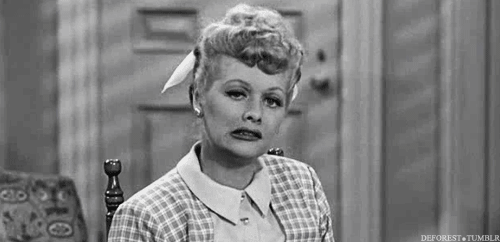Marisol Escobar was a beautiful, talented, peculiar it-girl with a knack for sculpture and freaking people out. Born in 1930 in Paris, Escobar’s parents were wild partiers. Marisol was more of a straight-edge kid so naturally she was furious with their behavior. She claimed that she thought that they were immoral.
This all changed when Escobar was 11 years old and her mother committed suicide. From that point on, Escobar decided to never speak again. She explained, “I really didn’t talk for years except for what was absolutely necessary in school and on the street ... I was into my late twenties before I started talking again — and silence had become such a habit that I really had nothing to say to anybody.” People talk too much anyway. But imagine trying to connect with her for those very quiet ten years.

The first wrong done to Marisol was obviously her mother’s suicide and the second was when her father shipped her off to boarding school on Long Island directly after that. Marisol claims that “that was the end of family life” for her. Eventually she was shipped back to LA with her family, but nothing was the same. At the age of 13 Marisol thought she was a saint; she “started walking on [her] knees until they bled, and [she] tied ropes around [her] waist until they really hurt.” At one point her brother said she was stupid for doing all of this, so she stopped. And so began a long life of men being freaked out by her and trying to get her to act “normally.”

Fast forward to the 1950s. Marisol has already been to art school at the Ecole des Beaux Artes and the Art Students League of New York and studied under Hans Hofmann at the New School of Social Research. She had the great honor of addressing The Club, “where the alphas of contemporary American art met. Franz Kline, Robert Motherwell, Willem de Kooning, and their ilk gathered there to take part in discussions, listen to talks, and escape their families. Abstract Expressionism was the house style and in its early days women, homosexuals, and communists were all barred from membership.” So it was a big deal that Marisol got the invite to participate in a panel discussion there. But in classic Marisol fashion, she showed up in a white mask that covered her face to the great detriment of the men in the room. They demanded that she take the damned thing off, and when she did, she revealed that her face was painted white underneath the white mask, causing quite the tizzy. I honestly can’t imagine anything funnier than sitting in a group of men who wholeheartedly believe that they are the masters of the universe and doing something so odd that they throw tantrums like little babies. Unfortunately, this satisfaction did not last long enough to keep Marisol in the art world.

As soon as she started getting famous for her work and getting shows, Marisol cracked under the pressure. It was 1957, and she had just had a group show with Jasper Johns and Robert Rauschenberg and her first solo exhibition ever, when Marisol took off for Rome. Leo Castelli, her gallerist, was really really pissed about it and just couldn’t understand why she would bail as soon as she started getting what literally every artist wants more than anything. “It could have been an immediate springboard into art-world fame if she had not bolted for Rome, where she lived for two years.” And during those two years, Marisol did a lot of drinking and not a lot of art-making.

After two years Marisol came back to claim her art world throne. She was BFFs with Andy Warhol and was the it-girl of the art world. “At MOMA, she participated in the The Art of Assemblage exhibition in 1961, and two years later she was given her own space to exhibit her works for the Americans, 1963.” Then in 1968 she exhibited at the Venice Biennale and for a while everything was relatively ok. Her personal life wasn’t fab, but her art was taking off so she held in there.
Admittedly her coping mechanisms during this time period weren’t great. She recalled, ‘I was stoned on marijuana all day and all night. That’s what I did.” She was also having lots and lots of sex. She explained, “I was promiscuous. My idea at that time was that sex should be normal, like eating.” This got her nowhere (obviously), and then she took off again. For several years she bopped around “in Tahiti, the Far East, India and Venezuela." She didn’t give a damn about what anyone thought of her, which was helpful because when she returned, the entire art world had evolved past her.

When she returned to New York, the art world was “in thrall to the vacuous conceptualism of the 1980s,” and it “soon found her style too nuanced, too handmade, and she faded from prominence.” It’s not like she expected the art world to pine for her or anything, but it would have been nice not to enter into complete obscurity the moment she got back. But whatever.

The worst part of the situation was that she was basically written out of history after that until Marina Pacini, the chief curator of the Memphis Brooks Museum of Art, dug her out of the hole she was buried in. In 2014, Pacini organized a retrospective of her work. Pacini wrote, “My aim was to return her to the prominence she so rightly deserves. Her inimitable sculptures and works on paper address some of the most compelling and topical issues of the last half century, from women’s roles and the disenfranchised, to a discussion of creativity and old age. Her works remain as important today as they were when she made them.” This was a valiant effort and was just in the knick of time because she died in 2016.

Sources
- Blumberg, Naomi. "Marisol | American Sculptor." Encyclopedia Britannica. Accessed September 25, 2018. https://www.britannica.com/biography/Marisol
- Goldberg, Jeffrey. "Pop Artist Marisol—20 Years After Her First Fame—Recalls Her Life And Loves." PEOPLE.com. Accessed September 24, 2018. https://people.com/archive/pop-artist-marisol-20-years-after-her-first-…
- Grimes, William. "Marisol, An Artist Known For Blithely Shattering Boundaries, Dies At 85." www.nytimes.com. Accessed September 25, 2018. https://www.nytimes.com/2016/05/03/arts/design/marisol-an-artist-known-…
- Karaicic, Nina. "Marisol Escobar." Widewalls. Accessed September 25, 2018. https://www.widewalls.ch/artist/marisol-escobar/
- Massie, Claudia. "What Happened To The First Lady Of Pop Art? | The Spectator." The Spectator. Accessed September 25, 2018. https://www.spectator.co.uk/2016/05/the-curious-case-of-the-first-lady-…
- Steinhauer, Jillian. "Marisol, Innovative Pop Art Sculptor Written Out Of History, Dies At 85." Hyperallergic. Accessed September 25, 2018. https://hyperallergic.com/295423/marisol-innovative-pop-art-sculptor-wr…










